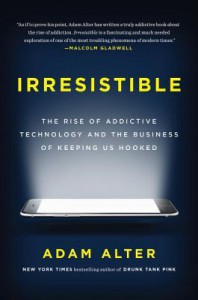Irresistible by Adam Alter

This is a pop psych book that has its problems but still has interesting information to offer in an accessible package. I would change the subtitle to “The Rise of Behavioral Addiction in the Digital Age,” which more accurately describes the book’s contents. It is not all about screens – the author discusses exercise addiction frequently – and it is in no way an exposé of the tech industry, as the actual subtitle might lead you to believe. Rather than focusing on how companies suck people into their products, the author is focused on the nature of behavioral addiction itself, how it affects people, and the aspects of technology that most readily create addiction.
The book starts off by discussing behavioral addiction generally, whether it’s an addiction to email, social media, gaming, gambling, or exercise. Like chemical addiction, this is often something that fills a hole in a person’s life, and that the person comes to depend on to feel good (if the addiction is the only thing that causes the person’s brain to produce dopamine anymore) but that ultimately is detrimental to his or her life. The author then moves on to discuss elements that can make technology addictive:
1) Goals: Technology creates goals for us that we might not have formulated on our own, like walking a certain number of steps per day. This is especially true of exercise addictions. One dangerous idea is the Running Streak Association, which celebrates people who have run every day for a period of time (as in years or decades): people who didn’t want to lose their streak have gone so far as to run while the eye of a hurricane was passing over, or while injured or even in the hospital for a C-section.
2) Feedback: Games tell you how you’re doing and how close you are to your goals; when you post on social media or message boards, you can track how many people liked your post.
3) Progress: The author talks about the illusion of near wins and the fear of losing, but it seems to me that the illusion of actually accomplishing something is an especially addictive aspect to games and some social media, particularly for people who feel like they’re just spinning their wheels at work or otherwise.
4) Escalation: This is especially true of games; the game gets harder and you get better at it.
5) Cliffhangers: Discussed in the context of Netflix binges; people don’t like unfinished stories and loose ends. In fact, a story sticks out far more in our memories if we don’t hear the end.
6) Social interaction: Keeps people on social media, and playing social games like World of Warcraft.
All good to be aware of, but the book’s message tends to get a little muddled. The author talks about “the addict in all of us” and how the average office email sits unread in the recipient’s inbox only 6 seconds, but then writes at length about a World of Warcraft addict who played 20 hours a day for 5 weeks straight before committing himself to a detox clinic. Detailing such extreme examples tends to make everyday overuse seem like not such a big deal, and repeatedly returning to the clinic and its methodology throughout the book isn’t especially useful for people whose technology dependence doesn't rise to the level of requiring a residential treatment program.
Wearable fitness devices are criticized throughout the book for promoting addiction (an exercise addiction psychologist, who unsurprisingly sees the people who are damaged by them, is quoted as saying no one should use wearables ever). Then in the final pages the author acknowledges that a device meant to increase motivation to exercise is likely to be helpful for those who need motivation, though potentially dangerous to those who are already motivated. Given that according to his numbers that 61-67% of Americans, Brits, Germans, Australians and others are overweight, perhaps he shouldn’t have slammed the fitbits quite so hard.
But suddenly in the last chapter gamification is presented as a solution to everything, when the entire preceding book was about why game addiction is bad. Sure, FreeRice promotes learning and donates ad revenue to feed the hungry, but it’s still a virtual game that creates artificial goals and uses progress and escalation to keep people hooked. Suddenly that’s okay if it’s for a good cause? I thought the point was that we were supposed to try to disconnect and focus on more meaningful things? What is the point, exactly? There isn’t a cohesive thesis here so much as a variety of interviews, studies and observations around a general theme.
Still, that doesn’t necessarily make a bad book; it’s informative though lightweight and sometimes confused in its presentation. If nothing else, it will probably make you reflect on the role of technology in your life, which is a good thing to check in on every now and then.






 1
1
 3
3